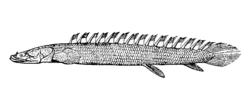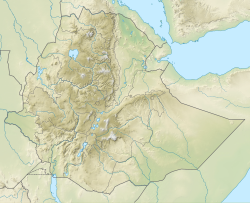Shungura Formation
Stratigraphic formation in the Omo river basin in Ethiopia From Wikipedia, the free encyclopedia
The Shungura Formation is a stratigraphic formation located in the Omo river basin in Ethiopia. It dates to the Late Pliocene to Early Pleistocene. Oldowan tools have been found in the formation, suggesting early use of stone tools by hominins. Among many others, fossils of Panthera were found in Member G of the formation.[1][2]
| Shungura Formation | |
|---|---|
| Stratigraphic range: Piacenzian-Gelasian | |
 Lower Omo Valley | |
| Type | Geological formation |
| Unit of | Omo Group |
| Underlies | Kalam Formation |
| Overlies | Mursi Formation |
| Lithology | |
| Primary | Sandstone, siltstone |
| Other | Claystone, tuff |
| Location | |
| Coordinates | 5.1°N 36.0°E |
| Approximate paleocoordinates | 5.8°N 36.1°E |
| Country | Ethiopia |
| Extent | Omo Subbasin Turkana Basin |
Geology
The formation comprises sandstones, siltstones, claystones and tuff, deposited in a fluvial to deltaic lacustrine environment.
Paleobiota
Summarize
Perspective
Fossil content
Color key
|
Notes Uncertain or tentative taxa are in small text; |
Among many others, the following fossils have been reported from the formation:[3][4][5][6][7][8][9][2][10] [11]
Mammals
Afrotheres
Hyracoidea
| Hyraxes of the Shungura Formation | |||||
|---|---|---|---|---|---|
| Taxa | Species | Locality | Material | Notes | Images |
| Gigantohyrax[12] | G. maguirei[13] | Member B. | A giant hyrax. | ||
Proboscideans
| Proboscideans of the Shungura Formation | |||||
|---|---|---|---|---|---|
| Taxa | Species | Locality | Material | Notes | Images |
| Loxodonta | L. adaurora | Member O | Extinct subspecies of African elephants. | ||
| L. exoptata | Member O | ||||
| Palaeoloxodon recki | P. r. shungurensis | Member A, B, C, D, and E. | An extinct elephant species native to Africa. |  | |
Artiodactyls
Bovids
| Bovids of the Shungura Formation | ||||||
|---|---|---|---|---|---|---|
| Taxa | Species | Locality | Material | Notes | Images | |
| Aepyceros | A. shungurae | Members B, C, D, E, F, and G | Extinct relative of modern impala. | |||
| Antidorcas | A. recki | Members B, C, D, E, F, G, and H. | Extinct relative of modern springbok | |||
| Beatragus | B. antiquus | Member G. | Extinct relative of modern Hirola. | |||
| Gazella | G. praethomsoni | Members F, G, and H. | An early relative of gazelle. | |||
| Kobus | K. ancystrocera | Member B, C, E, G, and J. | ||||
| K. ellipsiprymnus | Member G, J, and K. | A waterbuck. | ||||
| K. oricornis | Extinct relatives of the Kobus family. | |||||
| K. sigmoidalis | Members D, E, F, and G. | |||||
| Megalotragus | M. sp. | An alcelaphine. | ||||
| Menelikia | M. lyrocera | Members C, E, F, G, H, I, and J. | An extinct reduncinae artiodactyl. | |||
| Pelorovis | P. sp. | |||||
| Parmularius | P. altidens | Members G and H. | An extinct relative of alcelaphine. | |||
| Redunca | R. sp. | A reedbuck. | ||||
| Syncerus | S. cf. acoelotus | Members B, C, D, E, F, and G. | A cape buffalo. | |||
| Tragelaphus | T. gaudryi | Member F. | Relative of spiral horned anterlope. | |||
| T. nakuae | ||||||
Camelids
Giraffidae
| Giraffids of the Shungura Formation | ||||||
|---|---|---|---|---|---|---|
| Taxa | Species | Locality | Material | Notes | Images | |
| Giraffa | G. gracilis | Members D, E, F, and G. | Extinct relative of modern giraffe. | |||
| G. pygmaea | Members G. | |||||
| G. jumae | ||||||
| Sivatherium | S. maurusium | Member F. | An extinct giraffid. | |||
Hippopotamidae
| Hippopotamids of the Shungura Formation | ||||||
|---|---|---|---|---|---|---|
| Taxa | Species | Locality | Material | Notes | Images | |
| Hexaprotodon | H. protoamphibius | An extinct hippopotamid relative. | ||||
| H. shungurensis | Member C | A partial skull (calvarium and mandible) | ||||
| Hippopotamus | H. protoamphibius | |||||
Suidae
| Suidae of the Shungura Formation | |||||
|---|---|---|---|---|---|
| Taxa | Species | Locality | Material | Notes | Images |
| Kolpochoerus | K. limnetes | Members E, D, G, F, and H. | An omnivorous pig. |  | |
| Metridiochoerus | M. jacksoni | Members E, F, and G. | A giant warthog. |  | |
| M. modestus | Members G | ||||
| Notochoerus | N. euilus | Members A, C. | A tetraconodontinae suid. | ||
| N. scotti[15] | Members B, C, and H | ||||
| Nyanzachoerus | N. kanamensis | Members A, B | A tetraconodontinae suid. | ||
| N. jaegeri | Member A | ||||
Carnivora
| Carnivorans of the Shungura Formation | ||||||
|---|---|---|---|---|---|---|
| Taxa | Species | Locality | Material | Notes | Images | |
| Enhydriodon[16] | E. omoensis[17] | Member C. | Right femur (L 183–14), fragmented mandible, and lower dentition. | A lion-sized river otter. |  | |
| Dinofelis | D. petteri | Member A, B, C, D, E, F, and G.[18] | Damaged cranium skull and dentition fragments, OMO 1–768–3.[18] | A sabertooth cat. | ||
| D. sp.[18] | Member A, B, C, D, E, F, and G.[18] | Postcranial skulls (OMO 28-67-1075 from Member B), craniodental, and dentition fragments.[18] | ||||
| Helogale | H. hirtula | Extinct species of Mongoose family. | ||||
| H. kitafe | ||||||
| Homotherium | H. aethiopicum | Members C and G. | ||||
Chiroptera
| Bats of the Shungura Formation | |||||
|---|---|---|---|---|---|
| Taxa | Species | Locality | Material | Notes | Images |
| Hipposideros | H. kaumbului | Member F. | A Roundleaf bat. | ||
| Taphozous | T. abitus | Member F. | Extinct relative of tomb bats and sheath-tailed bats. | ||
Eulipotyphla
| Eulipotyphlas of the Shungura Formation | |||||
|---|---|---|---|---|---|
| Taxa | Species | Locality | Material | Notes | Images |
| Crocidura | C. aithiops | ||||
| Suncus | S. haesaertsi | Relatives of Shrews | |||
| S. cf. lixus | |||||
| S. shungurensis | |||||
Lagomorphs
| Lagomorphs of the Shungura Formation | ||||||
|---|---|---|---|---|---|---|
| Taxa | Species | Locality | Material | Notes | Images | |
| Lepus | L. capensis | Member E, and lower Members F and G. | ||||
Perissodactyls
- Chalicotheres
| Chalicotheres of the Shungura Formation | ||||||
|---|---|---|---|---|---|---|
| Taxa | Species | Locality | Material | Notes | Images | |
| Ancylotherium | A. hennigi[19] | Members D and G.[19] | Several tooth fragments and postcranial skeleton | A chalicothere. |  | |
- Rhinocerotidae
| Rhinocerotidaes of the Shungura Formation | ||||||
|---|---|---|---|---|---|---|
| Taxa | Species | Locality | Material | Notes | Images | |
| Ceratotherium | C. simum | Member A, B, C, D, E, J, K, L, and O. | Multiple dentition, cranium, and postcranial skeletion. | A white rhinoceros. | ||
| Diceros | D. bicornis | Member A, B, D, L, K, and O. | Complete Skull and Molars. | A black rhinoceros. | ||
- Equidae
| Equids of the Shungura Formation | ||||||
|---|---|---|---|---|---|---|
| Taxa | Species | Locality | Material | Notes | Images | |
| Equus | E. oldowayensis[20] | Members F, G, H, I, and J. | Jawbone mandible with complete dentition. | An Olduvai zebra. | ||
| Eurygnathohippus | E. libycum | Members C, E, F, G, and L. | A Hipparionine horse. | |||
| Hipparion | H. sitifense[21] | Members A, B, C, D, E, F, and G | Multiple cheek teeth and fragmented dentition. | Relatives of early horses. | ||
Primates
Cercopithecidae
| Cercopithecids of the Shungura Formation | |||||
|---|---|---|---|---|---|
| Taxa | Species | Locality | Material | Notes | Images |
| Dinopithecus | D. sp.[22][23] | ||||
| Paracolobus | P. mutiwa[23] | Member C, E, and G.[24] [11] | A skull, humerus and femur bone. | An early Colobinae monkey. | |
| Rhinocolobus | R. turkanaensis[23] [11] | Member C, E, and G.[24] | A skull humerus and femur bone. | An early Colobinae monkey. | |
| Theropithecus | T. brumpti | Members B, C, D, E, F, and G. | A skull | Extinct relative of Gelada Baboons. |  |
| T. oswaldi | Members D, E, F, G, H, I, J, K, and L. | A skull | |||
Galagidae
| Galagids of the Shungura Formation | |||||
|---|---|---|---|---|---|
| Taxa | Species | Locality | Material | Notes | Images |
| Otolemur | O. howelli | Member B. | L. 1-378 (right m2), L. 1-377 (holotype, left maxillary fragment) with P4-M1, and Omo 229-73-4018 (right mandibular fragment).[25] | Extinct relative of greater galago. | |
Hominins
| Homonids of the Shungura Formation | |||||
|---|---|---|---|---|---|
| Taxa | Species | Locality | Material | Notes | Images |
| Australopithecus | A. sp. | ||||
| Paranthropus | P. aethiopicus | Members C, D, E, and F. | |||
| P. boisei | Members G and K. | ||||
Rodents
| Rodents of the Shungura Formation | ||||||
|---|---|---|---|---|---|---|
| Taxa | Species | Locality | Material | Notes | Images | |
| Aethomys | A. deheinzelini | a rock mouse. | ||||
| Arvicanthis | A. sp. | |||||
| Acomys | A. sp. | |||||
| Gerbillus | G. sp. | |||||
| Heterocephalus | H. atikoi | |||||
| Jaculus | J. orientalis | |||||
| Mastomys | M. minor | |||||
| Paraxerus | P. ochraceus | |||||
| Pelomys | P. sp. | |||||
| Saidomys | S. sp. | |||||
| Tatera | T. sp. | |||||
| Xerus | X. sp. | |||||
Reptiles
| Reptiles of the Shungura Formation | ||||||
|---|---|---|---|---|---|---|
| Taxa | Species | Locality | Material | Notes | Images | |
| Euthecodon[26] | E. brumpti | Member H. | Complete partial skull. | A giant African long-snouted crocodile, formally named Tomistoma brumpti. | ||
Fish
| Fish of the Shungura Formation | ||||||
|---|---|---|---|---|---|---|
| Taxa | Species | Locality | Material | Notes | Images | |
| Auchenoglanis | A. sp. | Members F3 and G24. | Omo 199 1973-1278 and Omo 215 1973–2556, two pectoral spines, the former lacking the distalmost tip. | |||
| Clarias | C. sp. | |||||
| Gymnarchus | G. sp. | |||||
| Polypterus | P. bichir | Upper Member A. | An association of several rows of rhombic ganoid scales, Omo 40–4343. | A Nile Bichir. |  | |
| Sindacharax | S. greenwoodi | Relatives of African tetras. | ||||
| S. omoensis | Upper Member A. | Omo 128–72–22, Partial premaxilla (right) broken off lateral to the third outer tooth and second inner tooth, with first and second inner teeth in situ, and tooth bases visible of the first, second, and third outer teeth. | ||||
| Synodontis | S. frontosus | relatives of Mochokid catfishes | ||||
| S. schall | ||||||
See also
References
Further reading
Wikiwand - on
Seamless Wikipedia browsing. On steroids.

